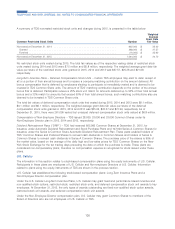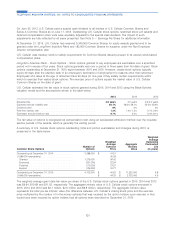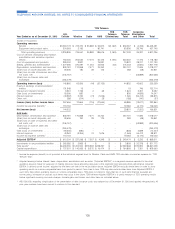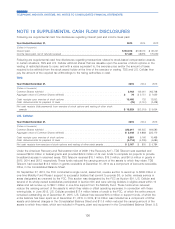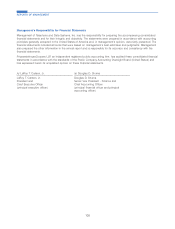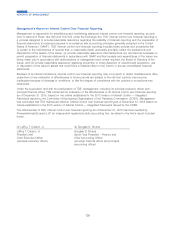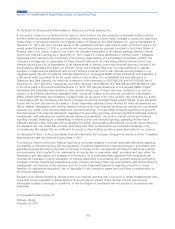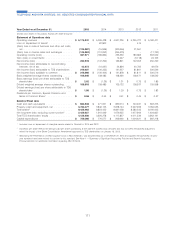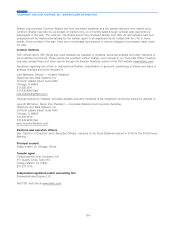US Cellular 2015 Annual Report Download - page 118
Download and view the complete annual report
Please find page 118 of the 2015 US Cellular annual report below. You can navigate through the pages in the report by either clicking on the pages listed below, or by using the keyword search tool below to find specific information within the annual report.
To the Board of Directors and Shareholders of Telephone and Data Systems, Inc.:
In our opinion, based on our audits and the report of other auditors, the accompanying consolidated balance sheets
and the related consolidated statements of operations, comprehensive income (loss), changes in equity, and cash flows
present fairly, in all material respects, the financial position of Telephone and Data Systems, Inc. and its subsidiaries at
December 31, 2015 and 2014, and the results of their operations and their cash flows for each of the three years in the
period ended December 31, 2015 in conformity with accounting principles generally accepted in the United States of
America. Also in our opinion, based on our audit, the Company maintained, in all material respects, effective internal
control over financial reporting as of December 31, 2015, based on criteria established in Internal Control - Integrated
Framework (2013) issued by the Committee of Sponsoring Organizations of the Treadway Commission (COSO). The
Company’s management is responsible for these financial statements, for maintaining effective internal control over
financial reporting and for its assessment of the effectiveness of internal control over financial reporting, included in the
accompanying Management’s Report on Internal Control over Financial Reporting. Our responsibility is to express
opinions on these financial statements and on the Company’s internal control over financial reporting based on our
integrated audits. We did not audit the financial statements of Los Angeles SMSA Limited Partnership and Subsidiary, a
5.5% owned entity accounted for by the equity method of accounting. The consolidated financial statements of
Telephone and Data Systems, Inc. reflect an investment in this partnership of $197,600,000 and $123,600,000 as of
December 31, 2015 and 2014, respectively, and equity earnings of $74,000,000, $71,800,000 and $78,400,000 for each
of the three years in the period ended December 31, 2015. The financial statements of Los Angeles SMSA Limited
Partnership and Subsidiary were audited by other auditors whose report thereon has been furnished to us, and our
opinion on the financial statements expressed herein, insofar as it relates to the amounts included for Los Angeles
SMSA Limited Partnership and Subsidiary, is based solely on the report of the other auditors. We conducted our audits
in accordance with the standards of the Public Company Accounting Oversight Board (United States). Those standards
require that we plan and perform the audits to obtain reasonable assurance about whether the financial statements are
free of material misstatement and whether effective internal control over financial reporting was maintained in all material
respects. Our audits of the financial statements included examining, on a test basis, evidence supporting the amounts
and disclosures in the financial statements, assessing the accounting principles used and significant estimates made by
management, and evaluating the overall financial statement presentation. Our audit of internal control over financial
reporting included obtaining an understanding of internal control over financial reporting, assessing the risk that a
material weakness exists, and testing and evaluating the design and operating effectiveness of internal control based on
the assessed risk. Our audits also included performing such other procedures as we considered necessary in the
circumstances. We believe that our audits and the report of other auditors provide a reasonable basis for our opinions.
As discussed in Note 1 to the consolidated financial statements, the Company changed the manner in which it classifies
debt issuance costs and deferred income taxes in 2015.
A company’s internal control over financial reporting is a process designed to provide reasonable assurance regarding
the reliability of financial reporting and the preparation of financial statements for external purposes in accordance with
generally accepted accounting principles. A company’s internal control over financial reporting includes those policies
and procedures that (i) pertain to the maintenance of records that, in reasonable detail, accurately and fairly reflect the
transactions and dispositions of the assets of the company; (ii) provide reasonable assurance that transactions are
recorded as necessary to permit preparation of financial statements in accordance with generally accepted accounting
principles, and that receipts and expenditures of the company are being made only in accordance with authorizations of
management and directors of the company; and (iii) provide reasonable assurance regarding prevention or timely
detection of unauthorized acquisition, use, or disposition of the company’s assets that could have a material effect on
the financial statements.
Because of its inherent limitations, internal control over financial reporting may not prevent or detect misstatements. Also,
projections of any evaluation of effectiveness to future periods are subject to the risk that controls may become
inadequate because of changes in conditions, or that the degree of compliance with the policies or procedures may
deteriorate.
/s/ PricewaterhouseCoopers LLP
Chicago, Illinois
February 24, 2016
110
REPORT OF INDEPENDENT REGISTERED PUBLIC ACCOUNTING FIRM


